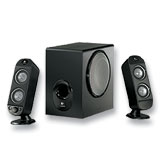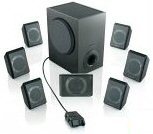
Sound Advice For Your PC
(March, 2006)
People who use their computers primarily as work tools typically focus on the visual aspects of their PCs, but those who value the entertainment side of a computer know that it is really an audio-visual device. To fully experience the audio dimension of a computer, you need to have speakers that are up to the task. If you’re still using that cheap little pair of speakers that came bundled with your budget PC, you are really short-changing yourself. Metaphorically, you are listening to the NC Symphony Orchestra through a telephone handset.
A typical starter set of speakers costs between $5 and $10. It will have an on-off button and a volume control. If you got the $12 set, you may have a tone control that spans the range from muffled to tinny. Yes, you can hear music on websites and you can hear a voice tell you that You’ve Got Mail. But if you really want to enhance your computer experience – even just for web surfing – you owe it to yourself to at least consider a speaker upgrade.
While PCs designed to deliver top quality sound will utilize an add-on sound card, most of today’s computers, in the interest of cost control, have the sound circuitry built right into the main circuit board (the ‘motherboard’), and in most cases the sound is pretty decent. When I’m talking about sound quality, I’m basically talking about three things: distortion-free volume, clarity, and accuracy. The better the speakers, the wider the range of the audible sound spectrum (20hz – 20Khz) that will be available to you. Some of this you hear, and some of this you feel.
Good things come in 3s…or more
A good set of speakers can greatly enhance your audio experience. Notice I said ‘set’ of speakers, not ‘pair’. Most good PC speakers are going to number at least three in their set, with the third being a sub-woofer designed to produce the lowest spectrum of sound. Subs should be placed on the floor, preferably close to a wall to enhance their output. Subs provide the thump and the boom, and are felt as much as heard. Yes, those are sub-woofers that those annoying people cruising around the mall parking lot are using to loosen your dentures from a hundred feet away. The difference is that you will understand the function of the volume control knob, which changes the experience from annoying to fulfilling.
Computer speakers are now sold with designations like 2.0, 2.1, 4.1, 5.1, or even 7.1. The first number designates the number of small speakers, often referred to as satellites, and the number after the decimal point indicates the number of sub-woofers. A good set of 2.1 speakers may be all you need if your use is limited to email, internet, spreadsheets, or checkbook keeping. If you are into watching DVDs or are a serious game player, a 5.1 setup might be something you would appreciate. A 5.1 system adds a center channel speaker for spoken language and a pair of rear ‘surround’ speakers for ambient effects. Most recently added to the speaker scene are 7.1 systems, which add a pair of side surround speakers. Sounds like overkill to me, but then again, I’m not a ‘gamer’. I suspect most of my readers will point out that they only have two ears, so why do they need more than two speakers. All I can say is that just like some people have the ability to see things others can’t see, other folks can hear with more acuity than the average person, and they may have greater appreciation for the added realism of surround sound. An avid gamer often wants to get his senses fully immersed in the gaming experience and feel like he is right in the action. There’s no better way to do that than with a strong, accurate sound system.
The cost of fidelity
So what is this experience going to cost you?
A good set of 2.1 speakers will start at around $30. A top-end 5.1 set will run
between $350 and $450, which may be as much as some folks have paid for their
whole computer. For most folks, you’re looking at between $30 and $130 for a
really good sounding setup.

As far as brands, many of the audio component speaker makers are represented in the PC speaker market, companies like Altec Lansing, JBL, Bose, and Klipsch. But probably the dominant brands in better PC speakers are Logitech and Creative Labs. Logitech made their name in pointing devices, especially mice. But they now sell a very competitive line of quality PC speakers in various configurations. Their Z-5500 5.1 unit gets rave reviews and packs an on-board amplifier that delivers an astounding 505 watts of power. But bear in mind the sub-woofer is the size of a living room hassock, and they’ll set you back all of $250 or more. For a 2.1 setup, look at their X-230 model, which delivers 32 watts of power for under $50.
Creative Labs was, and still is,
a leader in add-in sound cards. A few years ago, they bought Cambridge
Soundworks, a small maker of quality home audio speakers founded by audio
pioneer Henry Kloss. PC and multimedia speakers are now sold under the Creative
Labs brand. They offer one of the first 7.1 systems, their Inspire P7800 model,
which pumps out 90 watts of RMS power for
 under $100. Not enough? Try their
GigaWorks 750, another 7.1 system with 700 RMS watts of power. Aim the
subwoofer just right and you might be able to move your neighbor’s house – or at
least convince your neighbors to move. But be prepared to peel off a handful of
C-notes to purchase these beauties. If you are bothered by how to deal with
eight pair of speaker cables snaking around your computer room, you can visit
www.hifi.com or
www.creative.com to check out some of Cambridge Soundworks’ and Creative
Labs’ other offerings.
under $100. Not enough? Try their
GigaWorks 750, another 7.1 system with 700 RMS watts of power. Aim the
subwoofer just right and you might be able to move your neighbor’s house – or at
least convince your neighbors to move. But be prepared to peel off a handful of
C-notes to purchase these beauties. If you are bothered by how to deal with
eight pair of speaker cables snaking around your computer room, you can visit
www.hifi.com or
www.creative.com to check out some of Cambridge Soundworks’ and Creative
Labs’ other offerings.
Next time you’re at Big Box Electronics, mosey on over to the computer speaker section. Hopefully they’ll have a display of various models where you can make side-by-side comparisons with your own ears. If you’re still using two tinny little boxes for your speakers, take home a new set of speakers (at least a 2.1 setup) and plug them in. You’ll be glad you did.